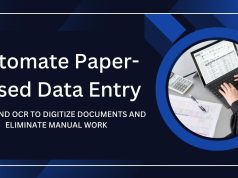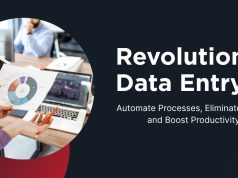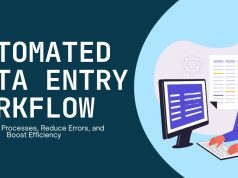Manual data entry eats up valuable time that could be spent on strategic work. If you’re copying information between applications, filling out forms repeatedly, or transferring data from one system to another, you’re likely spending hours each week on tasks that could be automated.
Windows offers several built-in tools and third-party solutions that can dramatically reduce your data entry workload. From simple keyboard shortcuts to advanced automation scripts, these methods can help you reclaim hours of productivity while reducing the risk of human error.
This guide will walk you through practical automation techniques that work on any Windows system, regardless of your technical expertise level.
Understanding Data Entry Automation Options
Data entry automation ranges from basic copy-paste shortcuts to sophisticated robotic process automation (RPA) tools. The right approach depends on your specific needs, technical comfort level, and budget constraints.
Simple automation might involve using Excel macros to populate recurring forms, while more advanced solutions could include Python scripts that automatically extract data from emails and input it into your CRM system.
Before diving into specific tools, identify which data entry tasks consume most of your time. Common candidates for automation include:

- Form filling with repetitive information
- Data transfer between applications
- File organization and naming
- Email processing and response generation
- Database updates and maintenance
Built-in Windows Automation Tools
Windows PowerShell for Advanced Users
PowerShell provides powerful scripting capabilities for automating complex data entry tasks. While it requires some learning, even basic PowerShell scripts can save significant time.
For example, you can create scripts that automatically rename files based on their content, extract data from multiple Excel files and combine them into a single document, or populate web forms using predefined data sets.
A simple PowerShell script might look like this: it reads data from a CSV file and automatically fills out a web form, eliminating the need to manually type the same information repeatedly.
Task Scheduler for Recurring Operations
Windows Task Scheduler allows you to run automation scripts at specific times or when certain conditions are met. This works particularly well for data entry tasks that need to happen regularly.
You can schedule scripts to run daily, weekly, or when your computer starts up. This is especially useful for tasks like backing up data, processing incoming files, or updating databases with information from external sources.
Clipboard History and Text Expansion
Windows 10 and 11 include clipboard history functionality that stores multiple copied items. While basic, this feature can speed up data entry when you’re working with frequently used information.
Enable clipboard history by pressing Windows + V, then access previously copied text, images, or other data without having to re-copy from the original source.
Third-Party Automation Solutions

AutoHotkey for Custom Shortcuts
AutoHotkey is a free, open-source tool that creates custom keyboard shortcuts and automates repetitive tasks. It’s particularly effective for data entry automation because you can create shortcuts that type entire phrases, fill out forms, or perform complex sequences of actions.
Common AutoHotkey applications include creating shortcuts that automatically type your name, address, and phone number, setting up hotkeys that open specific applications and navigate to frequently used pages, or automating mouse clicks and keyboard inputs for repetitive software tasks.
The learning curve is moderate, but the time savings can be substantial once you’ve created your automation scripts.
Robotic Process Automation (RPA) Tools
RPA tools like UiPath, Blue Prism, or Microsoft Power Automate provide enterprise-level automation capabilities. These platforms can handle complex data entry workflows that span multiple applications and systems.
RPA solutions work by “watching” your actions and then replicating them automatically. They can read data from emails, extract information from PDFs, input data into web applications, and even make decisions based on predefined rules.
While more expensive than other options, RPA tools offer the most comprehensive automation capabilities and often provide the highest return on investment for businesses with significant data entry requirements.
Text Expansion Software
Applications like PhraseExpress, TextExpander, or AutoText allow you to create shortcuts for frequently typed information. Type a few characters, and the software automatically expands them into full phrases, addresses, email signatures, or form data.
These tools are particularly useful for customer service representatives, sales teams, or anyone who regularly inputs similar information across different applications.
Excel and Database Automation

Macros for Repetitive Tasks
Excel macros can automate complex data entry procedures within spreadsheets. Record your actions once, then replay them automatically whenever needed.
Common macro applications include formatting imported data consistently, creating standardized reports from raw data, populating templates with information from databases, or performing calculations across multiple worksheets.
Visual Basic for Applications (VBA) allows for more sophisticated macro creation, enabling you to build custom data entry solutions that integrate with other Office applications.
Database Integration Tools
Tools like Microsoft Access, ODBC connections, or SQL queries can automate data transfer between different systems. Instead of manually copying information from one database to another, these solutions can synchronize data automatically.
This approach works well for businesses that need to maintain consistent information across multiple platforms, such as keeping customer information updated between CRM systems and accounting software.
Email and Communication Automation
Automated Email Processing
Email automation can significantly reduce data entry related to communication management. Tools like Outlook rules, Gmail filters, or specialized email processing software can automatically sort incoming messages, extract relevant information, and input it into appropriate systems.
For example, you might set up automation that reads order confirmations from your inbox, extracts customer and product information, and automatically updates your inventory management system.
Template-Based Responses
Create templates for common responses and use automation tools to populate them with specific information based on the context of each inquiry. This approach maintains personalization while dramatically reducing the time spent typing similar responses.
Web Browser Automation
Browser Extensions and Scripts
Browser automation tools can handle data entry tasks related to web applications. Extensions like iMacros or custom JavaScript can automatically fill out web forms, extract data from websites, or perform repetitive online tasks.
This is particularly useful for businesses that work with web-based CRM systems, online marketplaces, or any platform that requires regular data input through a browser interface.
API Integration
Many web applications offer APIs (Application Programming Interfaces) that allow direct data exchange without manual entry. While this requires more technical expertise, API integration provides the most reliable and efficient automation for web-based data entry tasks.
Implementation Best Practices
Start Small and Scale Up
Begin with simple automation tasks before moving to complex workflows. Automate one repetitive task at a time, measure the time savings, and gradually expand your automation efforts.
This approach allows you to learn the tools gradually while seeing immediate benefits from your automation efforts.
Maintain Data Quality
Automated data entry can introduce errors if not properly configured. Always include validation steps in your automation workflows to ensure data accuracy and consistency.
Regular monitoring and testing of your automated processes helps catch issues before they impact your work quality.
Documentation and Backup
Document your automation processes so others can understand and maintain them. Create backups of your scripts and configurations to prevent data loss if systems change or fail.
Measuring Automation Success
Track the time you spend on data entry tasks before and after implementing automation solutions. Most people find they can reduce data entry time by 60-80% with proper automation.
Consider both direct time savings and indirect benefits like reduced errors, improved data consistency, and the ability to focus on higher-value tasks.
Transform Your Workflow Starting Today
Data entry automation doesn’t require advanced technical skills or expensive software. Start with simple solutions like keyboard shortcuts and text expansion, then gradually incorporate more sophisticated tools as you become comfortable with the technology.
The key is identifying which repetitive tasks consume most of your time and selecting the appropriate automation approach for each situation. Even basic automation can free up hours each week that you can redirect toward more strategic and fulfilling work.
Choose one data entry task that you perform regularly and implement automation for it this week. Once you experience the time savings firsthand, you’ll be motivated to automate additional processes and maximize your productivity gains.










